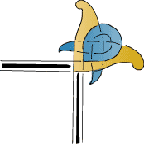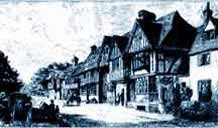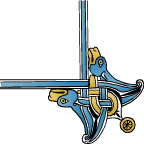MEMORIALS
This article is displayed in an oak frame on the north side of the west wall of St. Marys church in Chiddingstone. The source and date of it are not shown, but it refers to the memorial of Richard Streatfeild, which is an iron slab on the nave floor of the Church.
The strange memorial of Richard Streatfeilde.
You will find it in the centre aisle of Chiddingstone Church, the inscription covered with a piece of matting, but the rest of the iron plate exposed to passing footsteps. It has been thus exposed for three hundred years and more, and yet seems to have taken no harm. It is almost unworn and quite unrusted. It seems that Wealden iron rusts hardly at all, and some say that this is due to something in the oak wood with which the ore was smelted. Doubtless Richard Streatfeilde knew, for he was an iron master of note - as we shall presently see.
But first let us glance at the inscription. It begins with the usual words:"Loe, here the corpes." It is true that the maker of the plate, working perhaps at Furnace Farm, left out a letter in "corpes", but his intention is evident. After the name of Richard Streatfeilde there is a long parenthesis, "greene in yeres but ripe in faith & frutes", and only after that do we reach the rather unexpected verb "yet beene". The letter "b" is no longer to be deciphered in the original except for a portion of its upper part and this has led some to suppose that the word was "eene" and not "beene". Such persons have read "Yet eene God hath his soule" as commencing a new sentence. This is difficult to accept and "Beene" is good (or bad) Elizabethan for "is". We are e'en told that this archaic form was a common affectation of that period, something like "Ye Olde Inne" of today. Be it assured therefore that what the maker wished to convey was: "Loe, here is yet the corpse of Richard Streatfeild, God hath his soul."
All this may well be accepted but some explanation is needed of the words "greene in yeres and ripe in faith & frutes." It is true that he was only 40 when he died, but that is a distinction shared with many and should not alone suffice to earn so striking a phrase The truth is that Richard Streatfeilde - the family still keeps the more correct "e" before "i" - was an oustanding character. At the age of 22 he married Anne, the daughter (and co-heiress) of William Fremling of Kemsing. It is possible that this marriage provided some welcome funds. In 1595 Richard's father - Henry of High Street House - made over to his son all his property except the house and a few fields around it. Richard was at this time well engaged in the iron trade. He leased Canserne Forge in Hartfield in 1587 with "four payer of great tongs" and all other tools. In 1592 he leased Pilbeames Forge in Chiddingstone with "ground to lay Sowes of rawe yron", four more pairs of great tongs, etc. It is clear from the inventory taken at his death that he had also a lease of Furnace Farm in Chiddingstone and Hever. The Pilbeames Forge derived its water power from a damming of the Kent Water and the bank they made can still be seen, but the river has found its way through it and there is nothing left comparable to the furnace ponds in Cowden.
Besides his work as iron master, Richard did some farming and (since there were no banks or war bonds) a little money lending. At his death his household goods were valued at £59, his farm and cattle at £204, his iron stocks at £1,229, and debts owing at £584. His debtors included various local gentlemen such as George Rivers, Esq, as well as""Polle the bucher." He was certainly "ripe in frutes". As an index of his faith we may consider the words "the poor a portion large of all his worldly stoore". As a permanent endowment he left a croft of land which is now the south-western part of Water Lake House grounds. It is long known as the Poor Croft. He also left £10 in cash "to help maintenance of the poor" and half an acre in Cranstead Meade. The sum of £4 was to be distributed at his funeral following the custom of that time except that the sum was much larger than usual. Finally he left to the Parson and Churchwardens "the little house at the Church gate" subject to certain conditions. The conditions were
(l)that one of the poor should dwell in it "for ever";
(2)that in return he should pay 6s.8d. yearly towards the maintenance and amending of the clock in Chiddingstone Church; and
(3) that, if the clock "shall not go by the space of one whole year together" then the rent was to be paid to Henry Streatfeild and his heirs.
This little house has long since been demolished and the roadway runs where once it stood. Richard's will also tells us that he wished to be buried in the churchyard of Chiddingstone and that he left Mr. Dyas, the parson, 20s. to preach his funeral sermon. No doubt Mr. Dyas found little difficulty in justifying his burial in the Church itself. It is interesting to consider in what manner such a man lived. He certainly had a greater worldly store than already mentioned, for we know that the Burgh or Burrow lands were morgaged to him for considerable sums. One might expect that he would keep good house. But it certainly was not pretentious. His plate consisted of six dozen pieces of pewter, ten candlesticks and a few brass pots and pans, together with six silver spoons which were in his bedroom when the inventory was taken. He would appear to have had three male servants (who were probably farm hands) and one maid. These were content with little furniture, the maid's room containing an old flock bed with bedclothes and four or five stone of wool. The children one supposes slept in the "little chamber at the staires hedd" which was magnificently furnished with two old bedsteads, two old feather beds, a chair, a square table, a chest and a carpet. The only sign of luxury is afforded by the presence in the parlour of a wicker chair and six cushions.This must be one of the earliest mentions of a wicker chair. The usual seating accommodation is represented by various forms and stools.
The only articles which seem in excess of what we now expect are the 40 pairs of sheets, but as no blankets are mentioned the sheets may all have been needed to keep them warm. In general the inventory of his house shows Richard Streatfeilde as in no way given to sloth or ease, nor yet very learned. His writing was indifferent and, one imagines, rather laborious. His reading was restricted for he had but one book (remember he was ripe in faith) "an old bible" kept in the hall, the main room of the house. And so he died, on the 15th day of September in the year 1601 and in the 40th year of his age and over his remains you may see written to-day:"This Towne (hath) his Fame." By the courtesy of his descendant of the tenth generation, Sir Henry Streatfeild, it is permitted to the writer that he should bring that fame (some little part of it) to light again.
|
|


